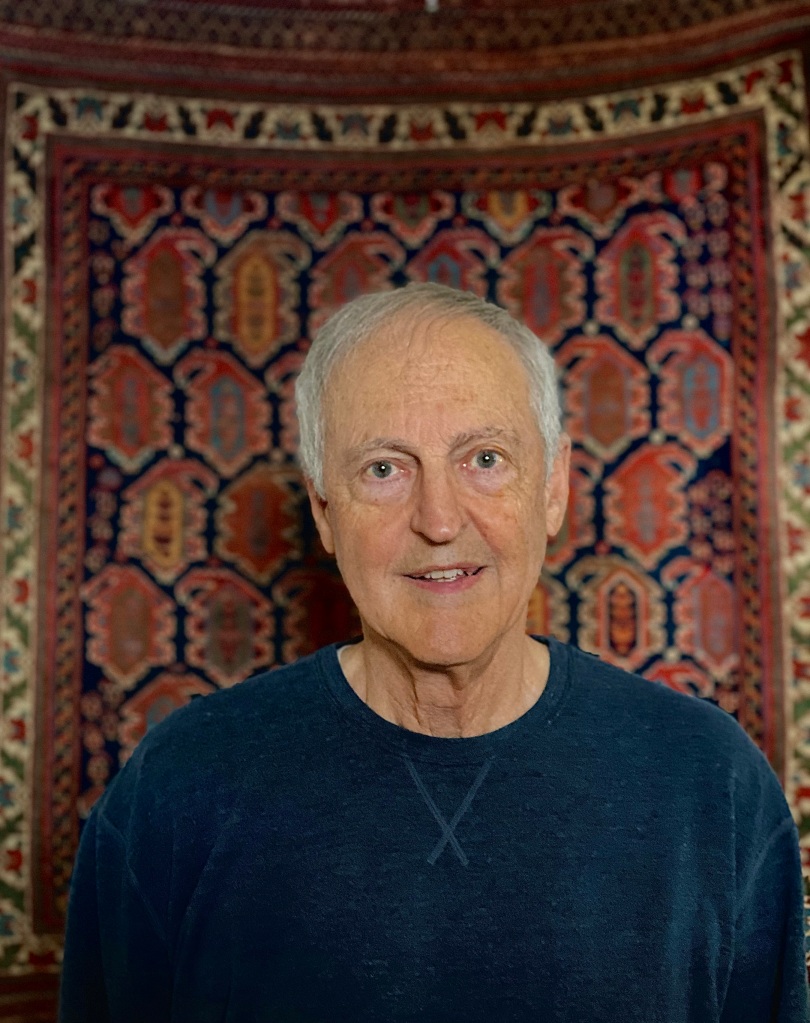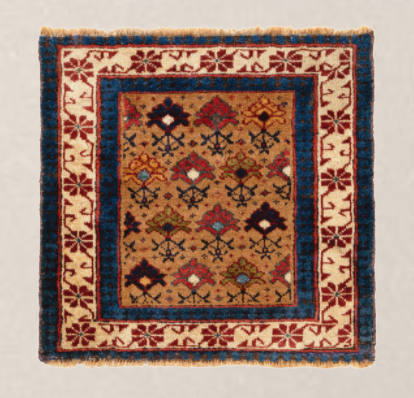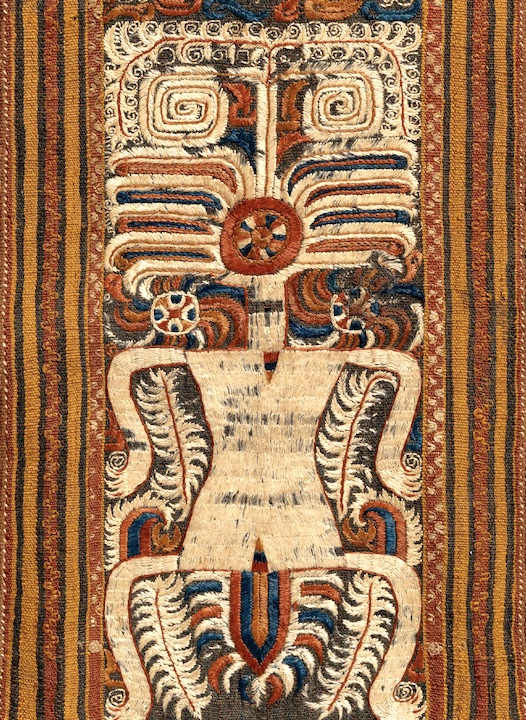
We have just been informed (by the curators) that the exhibition Ships and Passages, which was shown last year at the Ethnographic Museum of the University of Zurich, can now be experienced virtually, through the wonders of technology.

Make sure you click EN on the bottom blue menu, unless of course you speak fluent German. If you use the zoom function you also have the option to see the back of the textiles, which I found really useful.
Asian Textiles has published two articles relevant to this exhibition. The first, entitled Alfred Steinmann and the ship motif, was co-authored by Georges Breguet and Gaspard de Marval and appeared in number 79. The second appeared in our most recent edition (number 81) and was entitled Alfred Steinmann’s ship tapis inuh. It was co-authored by the curators Andreas Isler and Paola von Wyss-Giacosa, along with OATG members Richard Isaacson and Louise Shelley.
Asian Textiles is a great searchable resource and all issues, apart from the past three years which are password-protected for members, can be freely accessed here.

On Saturday 9 April 2022 the New England Rug Society (NERS) will host an online presentation by Michael Rothberg entitled Saddlebags from Persia and the Caucasus: An Examination of Selected Design Motifs.
Michael’s presentation will focus on aspects of design in nineteenth century knotted-pile transport bags woven by tribal women. He will draw most of his examples, including Shahsevan, Kurdish, Afshar, Khamseh Confederation, Qashq’ai, Luri, and Baluch bags, from his book, Nomadic Visions, which was published by HALI and the Near Eastern Art Research Center in 2021. He will also discuss examples from the Transcaucasus, Persian Azerbaijan, and Varamin.

Registration is free for this programme, which begins at 13:00 Eastern Time, which is 18:00 BST. If you have any questions please email Jean Hoffman.

An online exhibition by Hali of sixteen knotted pile bags from the Michael and Amy Rothberg Collection can be viewed here. The exhibition also includes several wonderful textiles from the collection of the late Neville Kingston, who was a member of the OATG for many years.

Also happening on Saturday 9 April is an in-person talk by Thomas Murray for the Textile Museum Associates of Southern California. His subject will be Archetypes, Aesthetics and Agency: Adat Textiles of Early Indonesian Cultures.
“Indonesian textiles are known to convey messages across time and space by means of an archetypal iconography that includes human figures, trees, boats, reptiles, birds and geometric patterns. These encoded images follow ancestral traditions and customary laws known as adat; cloth becomes sacred through a combination of fine spinning, dying, and weaving that creates a sense of aesthetic wonder……. This lecture will follow the themes presented in the newly published book, Textiles of Indonesia, and will focus on some of the finest cloths to come out of the archipelago, presenting each object with impeccable photographs.” – Thomas Murray

The programme begins at 10:00 PDT in Santa Monica, California and entry is limited to those with reservations. These must be received by 17:00 PDT on Thursday 7 April, so act now if you want to attend.
Don’t live in Southern California but would love to see this presentation? Then you just need to wait a little longer. The TMA/SC have arranged for two Zoom presentations later this month. The first is intended for participants living in Southeast Asia and Australasia and starts at 19:00 PDT on Friday 22 April. This is therefore 09:00 on Saturday morning for those in Jakarta and Bangkok as an example. Register here.
The second is timed for those in Europe and the Middle East. It will take place on Saturday 23 April at 10:00 PDT, which is 18:00 BST. You can register for it here.
Please ensure you register for the programme that best suits your time zone. Thomas Murray will be live at both Zoom presentations for the Q&A sessions.

On Sunday 10 April the Society for Art and Cultural Heritage of India will host an online talk by Urmila Mohan on Patola-inspired textiles in Indonesia as Forms of Spiritual Power. Dr Mohan is an anthropologist of material culture with a focus on clothing.
“While some of us know double-ikat as luxury textiles and handwoven traditions, based on Patola’s history as a trade commodity, we may be less familiar with the local ways in which Patola-inspired textiles are used in parts of Southeast Asia. This talk focuses on how these textiles acquire a new and different life in the Indonesian archipelago based on the creativity of weavers and dyers, and the ritual context of usage. While we can certainly admire these clothes for their artisanry and aesthetics, it is valuable to recognize that those very same qualities have real and tangible spiritual and cosmological effects in the societies within which they are embedded.” – SACHI website
This talk begins at 22:00 BST and you can register for it here.

On Tuesday 12 April Andean Textile Arts are hosting an intriguing Zoom presentation by Juan Antonio Murro entitled Written in Knots: What We Know Today About Khipus.
“Peru’s long-lived Wari and vast Inca empires employed sophisticated devices called khipu to record information, such as census data and labor obligations……. Made of cords, both Inca and Wari khipu seem to have recorded not only quantitative or statistical content, but narrative information as well. The variation in cord structures, colors, wrapping patterns, and knots encoded and conveyed information, while the basic elements—flexible knotted cords—offered a lightweight and compact means of transporting information across distances.” Andean Textile Arts
The talk begins at 19:00 Eastern Time, which is midnight in the UK – one for the nightowls. Click here for more details and registration.

On Tuesday 12 April the New York based Hajji Baba Club will host a Zoom presentation by Augusta de Gunzbourg on From Buteh to Paisley: The History of a Global Icon.
“This curved, drop-like shape is one of the rare forms that features on textiles from all around the world and on clothing worn by all genders or ages. The motif has many names and meanings according to the different cultures that have all adopted it. Seen on Indian saris or on the Queen of England’s clothing, the questions we ask are: where and when did this motif originate and how did it become such a global icon?
The way the motif traveled historically and geographically will be illustrated with a wide range of items with Paisley from the TRC’s exhibition such as Iranian Qajar jackets, 19th century British ladies’ shawls or even a modern Japanese kimono.”

Augusta’s talk will feature the exhibition held at the Textile Research Centre, Leiden in 2021, on the history of the Paisley motif. It is well worth delving into this online resource here.
The talk will begin at 11:00 Eastern, which is 16:00 BST. Places do need to be reserved by 8 April so send your RSVP now!

The next OATG event takes place on Thursday 21 April when we will have a presentation by Victoria Vorreiter on Hmong Threads of Life: Traditional Hmong Textiles of the Golden Triangle. Victoria is a violinist and music teacher who began documenting the ceremonies and music of indigenous people several decades ago. She moved to Thailand 17 years ago and now spends her time trekking to remote villages in Laos, Myanmar, China and Thailand. Her photographs are incredible – just take a look at her website!
Victoria’s online presentation begins at 13:00 BST. It’s an afternoon event as she is based in Chiang Mai in Thailand. It will of course be recorded and the recording will be made available to members. Non-members are welcome to attend for a small fee. More details and registration here.
In 2016 Victoria wrote a long, beautifully illustrated article for our OATG journal Asian Textiles, which you can read here.

On Saturday 23 April the Textile Museum of Canada, Toronto, has an in-person event – still something of a novelty for many of us. Egyptian artist Lamis Haggag and professional khayamiya craftsman Mostafa El-Lathy will host a presentation and workshop on the traditional Egyptian appliqué craft of khayamiya, used to decorate tents. This event will run from 14:00 – 16:00. Click here for more details.

Next an event that is definitely in-person! It’s the Textile Society’s annual Antique and Vintage Textile Fair in Manchester on Sunday 24 April. This is always such an eclectic mix, with textiles from around the world and across several centuries. It’s always very busy and the car park fills fast so get there early!
Full details and ticket booking via this link.

On Wednesday 27 April the Textile Museum in DC will host a virtual programme linked to their current exhibition Indian Textiles: 1,000 Years of Art and Design. Textile specialist Rosemary Crill (ex V&A) will discuss Abstract Patterns in Indian Textiles.
“The abstract and geometric patterns of Indian textiles are as varied as the innumerable techniques used to produce them, encompassing woven, surface and embellished cloths of all kinds. Geometric structures form the basis of all cloth with intersecting warps and wefts, and as such stripes and checks are found in the oldest textiles known from South Asia.”
This event takes place at 12:00 EDT, which is 17:00 BST . You can find out more and register for it here.
Don’t forget to let me know if you are aware of textile-related events that could be shared!